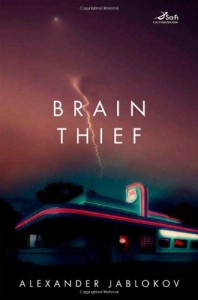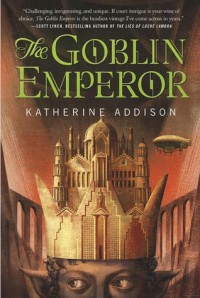
This book was fun. As reviews have said, this is NOT "Ready Player One".
This book was written as a screen play; there will be a movie.
All the familiar tropes are here but it is still fun.
 3
3

I wanted more of...I'm not sure exactly what, but I wanted more.
In some reviews I read Mr. Cohen was compared to Thomas Pynchon and David Foster Wallace.
This particular book was much closer to Pynchon than Wallace.
 2
2

Well, this book is disturbing. On many fronts. First, Anais would fit right in as a character in "Infinite Jest". This novel does not let up and is not for the feint of heart. This book is filled with violence and foul language; disturbed teens doing disturbing things to other disturbed teens and disturbed adults.
 3
3

An especially clever 'whodunnit'. The literary angle is a fresh take for me. I am tempted to give it 5 stars, but the twists at the end get to be a bit much. Given the plot - a 30 year old teenage missing girl case - is nothing new the writing is brisk and characters, while not deep, are well defined and believable.
I will be waiting on Mr. Dicker's next work.
 2
2

I am going to wait a month or two before finishing Eliza's and Jack Shaftoe's love story, "The System of the World" and follow it up with "Cryptonomicon".
I enjoyed "The Confustion" more than "Quicksilver" Particularly how Mr. Stephenson played European Aristocracy (Eliza's story) against the culture in the Middle East and Asia and Mexico (Jack's story). Meainng this book has less of the Daniel Waterhouse story (England).
This is a large sprawling series (which I like) classifed as Sci-Fi but much closer to historical fiction.
 2
2

I can't get enough of Mr. Murakami. This is more of a 4-star but his books are so far out there...I can't describe. Let me just say one character talks to cats. Nothing is what it seems in Murakami's world and I know I miss a lot (if not most) symbolism but his writing and characters are beautiful.
 2
2

I have one late teen and two soon-to-be-teen girls, so I know of Mr. Green. Saw the preview of the movie and it looked fun and light. I will take my two soon-to-be-teen girls when it opens at the end of July; great cover...all the other girls will think I'm a cool dad (and I am!)
It was fun and maybe not so light. I can't help but think Mr. Green is to writing (for millennials) as John Hughes was to movies in the 80's.
One last comment. "Fault in Our Stars" holds no interest for me. Two kids in love with cancer I'm out. Kids killing kids ("Hunger Games") in a dystopian future I"m all in. Sometimes there is no accounting for taste :).
 2
2

Hoping for something like "Moxyland" by Lauren Beukes.
It missed.
However, some flashes of talent. Perhaps a lot of talent. I'll be waiting for Ms. Byrne's next book
 2
2
Getting To Know Me
 1
1

I have put off reading this book because of the WWII setting. I read too many WWII books in my teens and it just doesn't interest me any longer. Also, I thought the book would be depressing and maudlin.
I was wrong.
I am at risk here to use too many cliches in describing the story, but Mr. Doerr's technique of going back in forth in time until all the stories come together on August 8th, 1944 is very effective.
All the chapters are short and the plot moves amazingly fast.
And "All The Light We Cannot See" is NOT depressing nor maudlin. Just a wonderful story of two ships passing in the night.
Damn. Almost made it :).
 1
1

Ok, if the book has a HERF gun and it gets used it's worth 1/2 star. So, I give this 3-1/2 stars.
Good plot and I enjoyed the eclectic characters but the story lurched from chapter to chapter at times making the narrative uneven.
As some previous reviewers have stated this is more of mystery than cyber-punk. Not a lot of hard science or technology (see The Martian).
 1
1

I have had this on my 'to read' list for several years and with Mr. Ihsiguro's recent release it came back to mind and I read it.
This is set in a very similar yet very different world than our own. The protagonist and her friends were all created around 1970.
It is difficult to write this and not give away too much of the plot. The important point is the context in which the book is written.
From that of Kathy H.
As she tells her story from her time growing up at school to the present a sense of dread builds.
We are never told about any of the science behind this world nor what the rest of this 'alternate' world is like. Kathy doesn't know these things; Kathy and her friends are not like everyone else. They are special and have a purpose.
This book was very unsettling to me. The straight forwardness of Kathy's narrative never questions anything about how they are and their purpose. This 'acceptance' is what unsettled me; and would I consent to live in a world like this.
 1
1

I can see where a book about a recently retired Englishman going on a long walk and reflecting on his life would not be interesting (perhaps meaningful is a better word?) to persons under, say, 40.
However, if you have more miles behind you than in front of you can appreciate the examination of "how did I get here"?
Overall a very good story, bogs down for just a bit in the middle.

3-Stars for Plot and Characters, 5-Stars for world, history and language creation.
I look forward to where Ms. Addison goes is this wonderful world she's created.
There's no epic battles or daring-do here just a touch of steampunk in this political story. I found the protagonist a bit boring.
But the rich history and conspiracies make this a good read. If you like fantasy and a lot of characters and family lines this is for you.
 1
1

A very good summer beach read. I've read where some compare or say "The Girl On The Train" is like "Gone Girl". Well, not really. I would say it's more like "Rear Window" from a train on a drinking binge.
The novel is short and moves quickly. Not a lot of character development, but then it's not really needed. 3.5 stars
Review, or something resembling a review of something not really reviewable

Dense.
This book is very dense. And very long.
It takes a few hundred pages to get into Mr. Wallace’s narrative cadence and the story. The book, published in 1996, takes place in the near ‘alternate’ future US (mostly Boston) that just happens to be around the early 2010’s (i.e. Now).
The majority of the novel occurs in November, Y.D.A.U.
Mr. Wallace’s Subsidized Time setting (Y.D.A.U, above), sudden transitions to different characters and points in time, both Subsidized and B.S, abundant footnotes (some of which are short stories and key to the narrative) and a very effective blending of ‘real’ items versus fictionalized items creates an uneasiness in the reader, me, that stays with you, me, throughout the book.
The above paragraph is very mediocre attempt at impersonating some of Mr. Wallace’s narrative style.
The novel itself is part mystery/thriller part character study. There are many themes in the book: entertainment, addiction, recovery, disfigurement, political satire, and more.
And it is long. And dense; many multiple page single paragraphs. And footnotes. Lots of footnotes.
For a book where all the characters have problems with addiction and all the characters come from a very dysfunctional families and all the characters experience pain, suffering, violence, extreme violence, brutality, etc… I did not feel the book was depressing. In fact, or because of the humor, it felt, for the most part, uplifting.
The book I read had a forward by David Eggars. Read it, if you decide to tackle this book. It took me five weeks. Mr. Eggars said it takes a month.
Some final random thoughts:
Be patient. All the back stories and alternate future items are eventually explained. Let the novel take you at its own pace.
David Foster Wallace was a genius.
I read this in eBook format. In an eBook I could ‘easily’ toggle back and forth between footnotes and the book (Yay!). If you read it in eBook format, BEFORE you start, remove any settings that sync your devices to “furthest point read”. This is important. You will take a break at some point in the footnotes. Your eBook reader will sync. You will get lost. It got so bad for me I had to delete it from all my readers and re-install it (after I updated my setting to NOT sync to “furthest point read”).
I did not read the entire footnote of James O. Incandenza’s filmography.
That is the only footnote I did not completely read.
I also recommend reading on a device with access to the Internet. You will want to check some things. As mentioned real v fictional blurs at times. Several of the words I searched for on the Internet, were annular (and get used to this word if you read Infinite Jest) in that I was directed to one of several “Infinite Jest” wiki’s where I discover the word/phrase is made up or, maybe, slightly misspelled, perhaps intentionally.
This book begins at the end which is readily apparent. After all the back stories and narrative gaps are filled (800 to 900 pages in) the book picks up speed like it is going to reach a culmination (back to the beginning, which is the end, annularly) where everything comes together. It doesn't. Infinite Jest stops. [a second bad pun here was deleted].
 1
1





